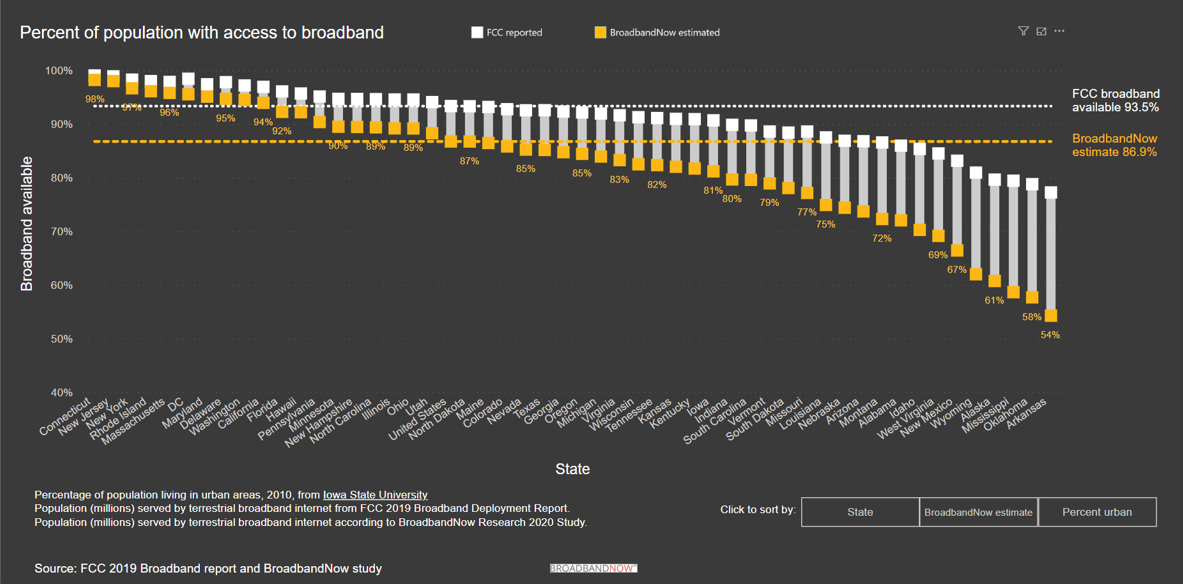The big service providers believe they will lose money on providing service to those areas so have avoided doing so, in part, by resisting government efforts to design more accurate maps of service delivery. JL
Karl Bode reports in Motherboard:
The government doesn’t actually know where broadband is available. The FCC’s $350 million broadband map routinely tells users they have the choice of six or seven ISPs, even if just one—or none—are available. It also fails to track consumers’ biggest broadband complaint: pricing.AT&T, Verizon, and Comcast have lobbied against efforts to improve broadband mapping, wary that more accurate data will highlight the competitive shortcomings that plague the U.S. telecom market—resulting in high prices, slower speeds, spotty coverage, and atrocious customer service.
The FCC’s 2019 Broadband Deployment Report states that 21.3 million Americans lack access to any broadband whatsoever, be it cable, DSL, fiber, or wireless. But according to a new study by broadband availability tracking firm BroadbandNow, that number is probably twice as bad as the FCC indicates, thanks to flawed FCC methodology and government apathy.
The firm examined broadband availability across the U.S. using more than 11,000 addresses from a dataset of 1 million. Those addresses were first compared to FCC data, then verified via the broadband availability websites of nine different internet service providers (ISPs).
Even taking a conservative approach to estimates, the group claims the actual number of unserved American households is closer to 42 million—double FCC estimates.
Why the disparity?
For decades the FCC has taken the broadband industry’s word on where broadband is actually available via “form 477” data collected from internet service providers (ISPs). The FCC then uses a flawed methodology to declare that an area is fully served with broadband even if just one home in a census block has service.
As a result, the government doesn’t actually know where broadband is available, and tends to view the problem through rose-colored glasses, something often reflected by FCC policy.
It only takes a few minutes fooling around with the FCC’s $350 million broadband map to get a good read on the problem. The map routinely tells users they have the choice of six or seven ISPs, even if just one—or none—are available. It also fails to track consumers’ biggest broadband complaint: pricing.
"I don't have a good answer for why the FCC hasn't moved faster on this,” BroadbandNow CEO John Busby told Motherboard. “It's been long known that the census-block approach overstates broadband availability, but the size of the gap hasn't been quantified or estimated. Our hope is that this study helps to spur the change needed.”
BroadbandNow’s study took the data and broke the problem down state by state, highlighting the significant difference between where the FCC says broadband is available, and where ISPs say they can actually provide service—an issue that’s worse in rural markets.“FCC overreporting disproportionately impacts rural communities,” the researchers said. “As an example, in South Carolina, where 50 percent of residents live in an urban area, unserved addresses are 30 percent higher than FCC estimates.”BroadbandNow is just the latest to point out the FCC doesn’t actually know where U.S. broadband exists. Last year Microsoft made similar complaints in filings with the agency, as have consumer groups and Senators eager to obtain subsidies for state-level broadband improvement efforts.
ADVERTISEMENTGiant broadband providers like AT&T, Verizon, and Comcast have historically lobbied against efforts to improve broadband mapping, wary that more accurate data will highlight the competitive shortcomings that plague the U.S. telecom market—resulting in high prices, slower speeds, spotty coverage, and atrocious customer service.
At the same time the FCC has lagged on fixing its broadband mapping, it has fought against local town and city efforts to build better broadband networks. Trump FCC commissioners have falsely insisted community broadband poses a threat to free speech, and the agency has supported state laws—usually written by industry—banning or hindering such networks.The FCC finally acknowledged the mapping problem last summer, announcing it would consider a more granular approach using crowdsourcing and geospatial data provided by ISPs. Those efforts have yet to materialize, and the wireless sector is currently lobbying the FCC to have next-generation 5G wireless networks excluded from any mapping improvement efforts.
The FCC did not respond to a request for comment.
ISPs could simply report availability based on individual street-level addresses, but efforts by the previous FCC to embrace address-level data were also opposed by the industry.
“We believe that address-level availability data is essential to close the digital divide, and that Americans should have clear and open information about how they can purchase high-speed internet,” Busby told Motherboard.FCC boss Ajit Pai has long insisted his top priority is curing the digital divide. But you can’t fix a problem you don’t understand, and there’s no indication we’ll be getting a solid handle on the scope of the U.S.’ broadband monopoly problem anytime soon.




















0 comments:
Post a Comment